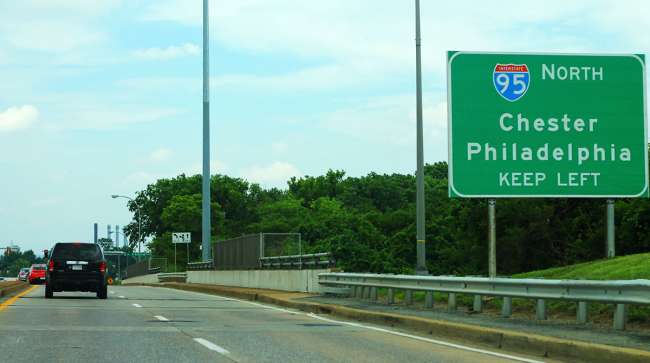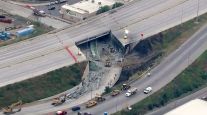After 60 Years, I-95 Is Complete

Across the United States, public infrastructure is crumbling because of legislative gridlock and chronic underfunding. Roads are overcrowded, bridges are well past their expiration date and transit systems regularly face unprecedented delays. But there will be one thing to celebrate as you seethe in beach traffic this weekend—a small, strange gap in I-95 is being filled.
Come September, one of the most audacious public infrastructure projects in U.S. history will be completed after more than six decades of work. Interstate 95 was the crown jewel of the American highway system championed by President Dwight Eisenhower, and yet the plan for an artery stretching the length of the East Coast almost didn’t happen—because of local lawmakers and land-owners in Mercer County, N.J.
Near the Pennsylvania border, drivers have long been forced off the interstate and onto other roadways, only to join back 8 miles away. Transportation officials and civil engineers spent more than two decades and $425 million to eliminate this detour off I-95, the most traveled highway in America, spanning 1,900 miles from Miami to Maine.
The Pennsylvania Turnpike Commission, which oversees the I-95 Interchange Project, said the new infrastructure—which includes the creation of flyover ramps, toll plaza facilities, environmental mitigation sites, intersections, six overhead bridges, widened highways and new connections to the New Jersey and Pennsylvania turnpikes—will be open to the public by Sept. 24.

“The benefit of completing this ‘missing link’ is mobility,” said Carl DeFebo, the director of public relations at the Pennsylvania Turnpike Commission. The new infrastructure will reduce traffic time for north- and south-bound travelers and ease congestion on local roads that used to connect I-95 to the Pennsylvania Turnpike.
I-95 will be the last infrastructure project financed by Eisenhower’s 1956 National Interstate and Defense Highways Act. The legislation authorized $25 billion — about $230 billion in 2018 dollars—for the construction of 40,000 miles of the Interstate Highway System. At the time, the act marked the largest public-works project in American history.
Today, I-95 is host to more than one-fifth of the nation’s road miles and serves 110 million people in the most densely populated region in the country. The road is the main thoroughfare for national economic activity, facilitating 40% of the country’s gross domestic product, according to the I-95 Corridor Coalition.
So why did it take six decades to complete the last—and most important—highway in the country? Local opposition to development that would follow the roadway through rural New Jersey. “Ultimately, it is a state decision to advance an interstate project,” said Brandye Hendrickson, the deputy administrator of the Federal Highway Administration.
“There’s a natural disincentive for local governments to be a leader in long-distance infrastructure,” said Adie Tomer, a fellow at the Metropolitan Policy Program of the Brookings Institution. “They have their own fiscal challenges and need to be judicious with what they spend their money on. So, local authorities can create tensions with entire states.”
Frustrated with such regional intransigence, Congress passed the Surface Transportation Assistance Act in 1982. Rather than construct part of I-95 in Mercer County, the act mandated the completion of the interstate using existing state turnpikes.
Thirty-six years later, the “missing link” is a month from opening. New connections finally will allow for a seamless highway through 15 states, and portions of the New Jersey and Pennsylvania turnpikes will be redesignated, flaunting brand-new I-95 signs.

Public-policy and infrastructure experts, however, see this small victory as a dangerous distraction from the calamitous condition of the nation’s infrastructure as a whole. Because of decades of political unwillingness to pay for necessary upkeep, it’s estimated that spending on infrastructure from 2016-25 is $2 trillion short of what’s needed, according to the American Society of Civil Engineers.
And even in central New Jersey, the completed highway won’t solve bigger problems. While the Interchange Project temporarily will clear up local roads, it won’t remedy long-term congestion. The I-95 Corridor Coalition estimates the number of vehicles on I-95 will increase 85% by 2035. Transportation officials don’t have a solution for that yet.
Meanwhile, the Trump administration has tapped the private sector to pay for repairs to America’s roads and bridges. The White House’s proposed budget for fiscal year 2018 calls for $1 trillion investment in infrastructure over the next decade, with $200 billion in direct federal spending and at least $800 billion in spending by states, municipalities and private entities. However, President Donald Trump has yet to outline details for the plan — and the administration has said action on a bill isn’t likely this year.
New Jersey in particular faces a number of transportation challenges, due to a lack of state funding (elected officials have long been reluctant to raise the gas tax, typically used to fund road projects) and Trump’s refusal to help fund a critical link to the Northeast.
The Lincoln Tunnel, which brings 200,000 passengers by car and bus from New Jersey to New York City each day, is in a decrepit state, as are the highways that lead to it. NJ Transit’s commuter-rail system is struggling to compensate for crowding, delays, faulty technology and a lack of engineers. About 42% of New Jersey’s roads remain deficient, costing each state driver an estimated $1,951 annually in lost time, according to a 2016 report from the American Society of Civil Engineers.
Most dangerously, the proposed $11 billion Gateway rail tunnel under the Hudson River, meant to relieve century-old passages severely damaged in 2012 by Superstorm Sandy, still is in question because of Trump’s opposition to funding promised by the Obama administration (an earlier tunnel project was killed by then-New Jersey Gov. Chris Christie).
A shutdown or collapse would do severe damage to the regional and national economy. Unfortunately, Tomer said, completing I-95 won’t stop that.
“As much as this interstate can offer a glimmer of positive news, New Jersey needs to grapple with some very real questions in the coming decade,” he said.




